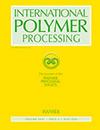A comparative study on adhesive properties of nanoparticle reinforced epoxy bonded single-strap repaired composites
IF 1.1
4区 工程技术
Q4 ENGINEERING, CHEMICAL
引用次数: 0
Abstract
Abstract This study aimed to evaluate the impact of nanoparticle inclusion and patch size on the bonding performance of single-strap repaired glass-reinforced composite plates through experimental investigations. Epoxy adhesive was modified with three different nanoparticles: nano-silica (NS), nano-graphene (NG), and nano-clay (NC) at varying weight contents. The patch repair performance of the test samples was evaluated using two patch ratios (Patch diameter ( D )/Hole diameter ( d ) = 2 and 3) to explore the influence of patch size on repair effectiveness. GFRP composite base plates having a 10 mm diameter hole in the middle were patch repaired by using patches with the same material. Tensile tests were conducted to compare the tensile performance of the repaired composite samples, and the results were compared with the samples with and without holes. Based on the findings, it was noted that samples with a larger patch ratio ( D / d = 3) can withstand higher tensile loads compared to those with a patch ratio of 2. Moreover, it was found that the specimen repaired with 3 % by weight NC-filled epoxy adhesive showed the greatest increase in tensile load value. This increase was recorded at both patch rates, with a percentage improvement of 2.8 and 19.54 % compared to pure epoxy adhesive. Also, it was observed that when the patch ratio was 3, the 3 % NS-filled adhesive showed an increase of 3.3 %. On the other hand, all combinations of NG-filled adhesive showed a decrease in maximum tensile load values.纳米颗粒增强环氧树脂单带修复复合材料粘接性能的比较研究
摘要本研究旨在通过实验考察纳米颗粒包合和贴片尺寸对单带修复玻璃增强复合材料板粘结性能的影响。用不同重量含量的纳米二氧化硅(NS)、纳米石墨烯(NG)和纳米粘土(NC)对环氧胶粘剂进行改性。采用两种补片比(补片直径(D)/孔直径(D) = 2和3)评价试件的补片修复性能,探讨补片大小对修复效果的影响。对中间有直径10mm孔的GFRP复合基板,采用同种材料的补片进行补片修复。通过拉伸试验对修复后的复合材料试样进行拉伸性能比较,并将结果与带孔和不带孔的复合材料试样进行对比。根据研究结果,与贴片比为2的样品相比,贴片比较大(D / D = 3)的样品可以承受更高的拉伸载荷。此外,研究发现,用3%重量的nc填充环氧胶粘剂修复后,试件的拉伸载荷值增加最大。在两种贴片率下都记录了这种增加,与纯环氧胶粘剂相比,百分比提高了2.8%和19.54%。当贴片比为3时,3% ns填充的胶粘剂增加了3.3%。另一方面,所有ng填充胶粘剂组合的最大拉伸载荷值都有所下降。
本文章由计算机程序翻译,如有差异,请以英文原文为准。
求助全文
约1分钟内获得全文
求助全文
来源期刊

International Polymer Processing
工程技术-高分子科学
CiteScore
2.20
自引率
7.70%
发文量
62
审稿时长
6 months
期刊介绍:
International Polymer Processing offers original research contributions, invited review papers and recent technological developments in processing thermoplastics, thermosets, elastomers and fibers as well as polymer reaction engineering. For more than 25 years International Polymer Processing, the journal of the Polymer Processing Society, provides strictly peer-reviewed, high-quality articles and rapid communications from the leading experts around the world.
 求助内容:
求助内容: 应助结果提醒方式:
应助结果提醒方式:


